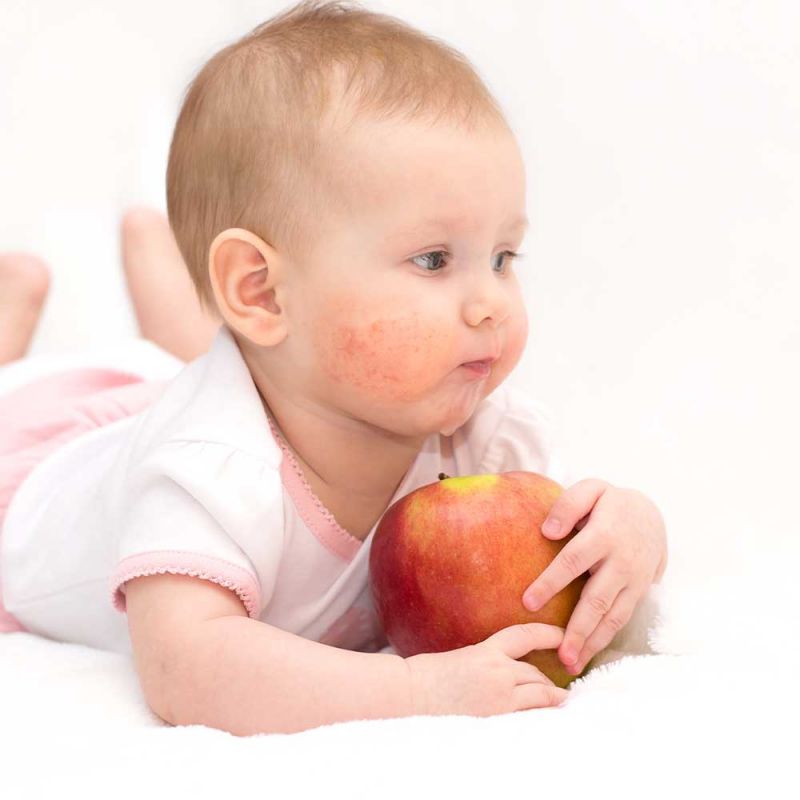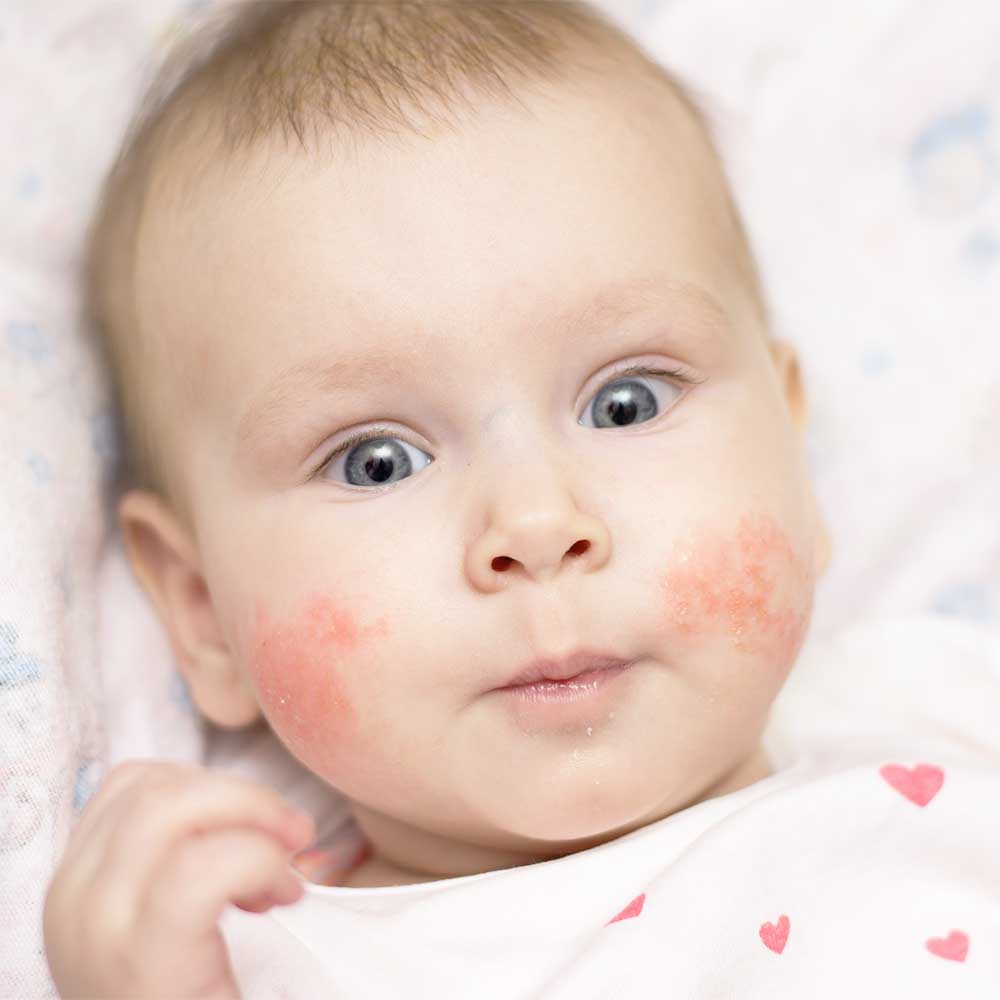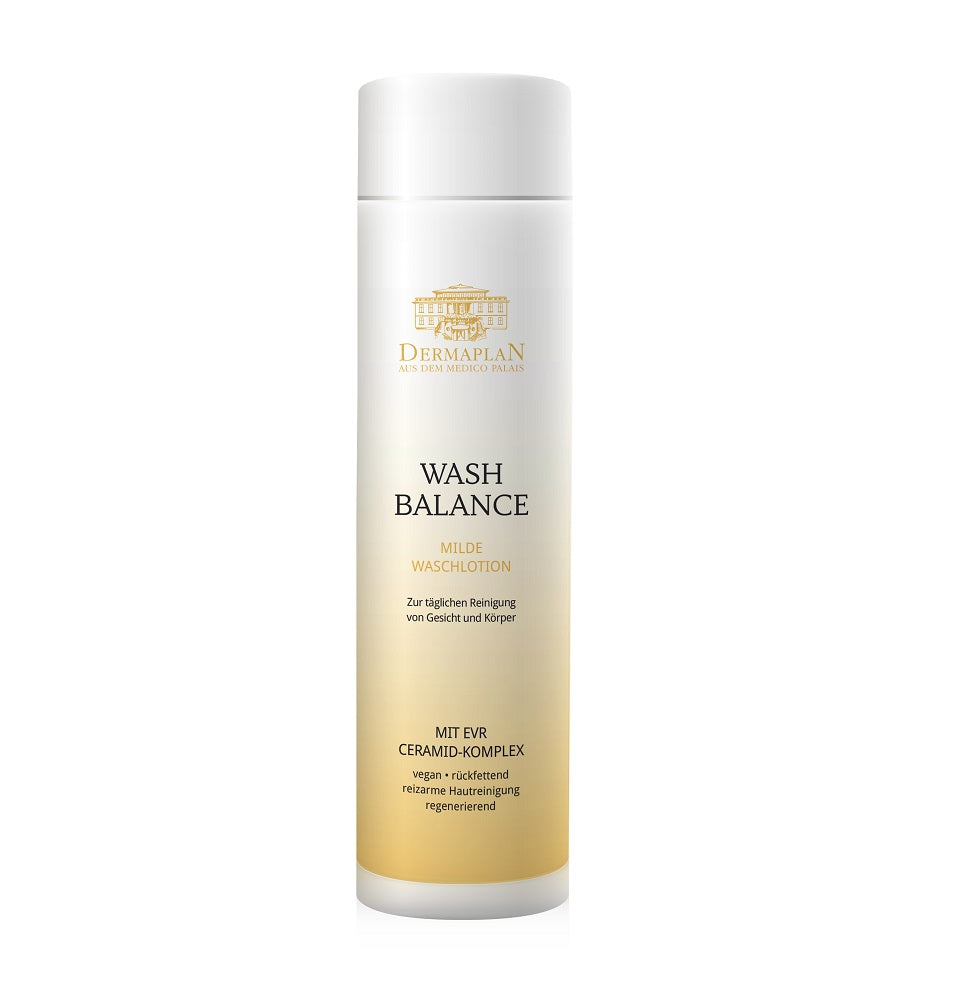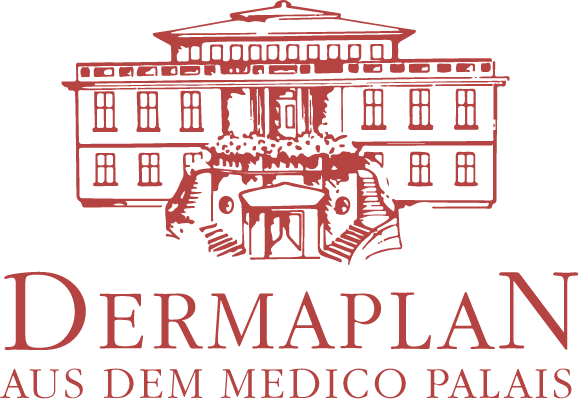ATOPIC DERMATITIS IN BABIES
Dry, red, itchy, and sometimes flaky skin: These are considered typical symptoms of atopic dermatitis. Babies are particularly affected. Such changes can be observed in almost a quarter of young children. The good news: The symptoms often diminish in subsequent years, so that only about eight percent of school-age children have to deal with the symptoms. With regular care and the ideal treatment, the condition of atopic dermatitis in children also improves. With this guide, we aim to provide comprehensive information on this topic and make it easier for you as parents to deal with this skin problem in your child.
The special features of baby skin
The skin is the sensory organ through which a baby intensely perceives external stimuli immediately after birth. Meanwhile, the eyes and nose need more time to react optimally to influences. Through their skin, little ones immediately sense touch, warmth, and cold. However, this sensory organ is not yet fully developed – and this is where its uniqueness lies. Compared to the protective barrier of adults, it is between three and five times thinner. This alone makes it more sensitive to various stimuli. But these are by no means all the characteristics of baby skin. We summarize the most important ones in the following overview:

Sebaceous and sweat glands not yet fully developed
• Grease film for protection is still missing
• Skin tends to dry out more quickly
• no fully stable acid mantle yet
• generally higher risk of infections
• Bacteria and harmful substances can penetrate the skin more easily
Relationship between skin surface and body weight
• Compared to an adult, the ratio of skin surface to body weight in a baby is more than twice as large
• means a larger attack surface for external factors
• Water is lost more easily through the skin
not fully developed lipid film
• Baby skin absorbs moisture more easily, but releases it just as easily
• dry skin can lead to inflammation or irritation
weak melanin production
• Low self-protection of the skin against UV radiation
In a nutshell, there are three main risks for baby skin. Due to the lack of moisture, it is more prone to drying out and becoming more susceptible to pathogens. It is also more sensitive to cold temperatures, as the fatty tissue responsible for thermoregulation has yet to fully develop. Finally, infant skin has very limited sun protection, so it should not be exposed to UV light.
From cradle cap to atopic eczema: Important terms about atopic dermatitis in babies
When parents first encounter the problem of atopic dermatitis in babies, they often hear the terms "atopic dermatitis" and "cradle cap." What exactly do these terms mean? We'll explain what they mean and what you should know about them.
Atopic eczema
Atopic eczema is an alternative term for neurodermatitis. Another frequently used term is atopic dermatitis. Both describe a condition characterized by dry, itchy, and often inflamed skin. It is a chronic problem that can be attributed to a variety of causes.
This is caused, among other things, by a genetic disorder of skin function. Additional influences—also known as provoking factors—such as allergies, improper clothing, or stress trigger the outbreak. Atopic eczema generally occurs in all age groups. Neurodermatitis is most common in children up to five years of age. This skin disease is not contagious. It is characterized by alternating symptom-free phases and flare-ups.
Cradle cap
Atopic dermatitis, baby: When these two keywords are combined, a third term isn't far away: cradle cap. It's considered the first sign of this skin disease and can be observed from the age of three months. Fluid-filled blisters form on the scalp of newborns. Gradually, they develop into white, sometimes yellowish-brown crusts. Because this visually resembles burnt milk, the term "cradle cap" was coined. This change doesn't just occur on the scalp—it can also extend to the forehead, cheeks, and other areas of the face.
However, if this phenomenon occurs, it doesn't automatically mean that the baby is suffering from atopic dermatitis. It could also be harmless cradle cap, which is caused by a temporary overproduction of sebaceous glands. More than half of all infants experience this type of dandruff on their scalp.

Does my baby have atopic dermatitis? These are the typical symptoms
The cradle cap described above can be – but does not necessarily – a precursor to atopic dermatitis. Unlike harmless cradle cap, however, it is accompanied by itching. Nevertheless, cradle cap does not necessarily mean that long-term skin problems are to be feared in the affected child. This phenomenon often disappears by the age of two, and no further symptoms of atopic dermatitis are observed. However, it is always advisable to consult a doctor. If the chronic skin condition is present, early treatment ideally helps to slow its spread.
Atopic dermatitis in babies affects other parts of the body. These areas exhibit redness, sometimes severe itching, and scaly eczema. The skin is also severely dry. The areas where the changes primarily occur depend on the age of the baby. Atopic dermatitis in babies most commonly occurs in the head area, such as the face or ears.
Typical areas of eczema in young children are the elbows, the inside of the arms, the wrists, and even the knees. This is also referred to as flexural eczema. Other areas that can be affected include the neck, back of the neck, shoulders, thighs, buttocks, the tops of the feet, and the hands. Atopic dermatitis can also affect children on the face. Here, it also affects the lips and eyelids.
Possible triggers for atopic dermatitis in children
The question of what triggers atopic dermatitis is still not fully understood. What is certain, however, is that it is based on a congenital predisposition. If at least one of the parents is affected by the skin disease, there is a 40 percent risk that the child will also develop it. This probability rises to 67 percent if both the mother and father suffer from atopic dermatitis. Additional factors that can exacerbate the risk include allergic asthma and various allergies, such as those to house dust mites or pollen.
Food intolerances are also typical triggers for atopic dermatitis in children. Such allergies can affect products such as soy, wheat, cow's milk, or nuts. Because children develop a growing tolerance to these foods over time, atopic dermatitis in children often lessens.
Dyes, preservatives, dust, dry skin, and excessive sweating are all other triggers of atopic dermatitis. It can also occur through contact with wool fibers. Even a deficiency of certain proteins impairs the skin's barrier function and should be considered as a potential cause. Extreme heat or cold is also mentioned as a trigger for atopic dermatitis in children. Psychological tension such as stress can also be considered as a possible factor.
Atopic dermatitis in babies: These are the risks
If a baby develops atopic dermatitis, it carries certain risks. It's especially difficult to stop small children from scratching. Given their dry skin and the typical itching, such a reaction is entirely understandable. However, scratching can cause wounds. The damaged protective barrier is then less able to keep out bacteria and other pathogens. This increases the likelihood of infections. This affects the condition of the skin, which subsequently worsens, often leading to increased itching. This is often referred to as a vicious circle.
Atopic dermatitis in older children can also have psychological consequences. The skin changes are perceived as disturbing and increase stress—which, in turn, is a potential factor that can exacerbate the condition. Nighttime itching causes sleep disturbances and leads to tiredness and stress during the day.
Can atopic dermatitis in babies be prevented?
Preventing atopic dermatitis in babies is particularly beneficial when there is a family history of the condition. This applies when one or both parents are affected by atopic dermatitis and other atopic diseases such as allergic asthma, hay fever, or food allergies are present. Under these circumstances, some tips can be considered to reduce the risk of atopic dermatitis in babies.
Avoid smoking:
Smoking is considered taboo during pregnancy anyway. It poses a risk for various diseases, including atopic dermatitis. However, cigarettes should also be avoided after birth, as tobacco smoke is considered a potential trigger for the skin disease.
Breastfeeding:
Mothers are advised to fully breastfeed their babies for at least the first four months after birth. This also reduces the risk of the infant developing atopic dermatitis.
Mother’s nutrition:
A balanced diet for the mother during pregnancy and breastfeeding should be taken for granted. Regularly including fish in the diet is advisable. This has been proven to help prevent atopic diseases.
Baby nutrition:
Fish can be consumed not only by mothers themselves, but also by their children during their first year of life. The reasons for this are identical: It reduces the risk of atopic diseases such as atopic dermatitis. From the fourth month of life, complementary foods are advisable for babies. For children at risk who cannot be fully breastfed, hypoallergenic infant formula is recommended. In such cases, however, breast milk substitutes such as soy or cow's milk should be avoided.
The right care if your baby has atopic dermatitis
Many parents search the internet for tips on how to best care for their child's skin using the two terms "baby atopic dermatitis." There's a fairly simple rule that summarizes the most important things:
A – anti-inflammatory
B – Strengthen the barrier
C – Care
Ideally, a children's atopic dermatitis cream combines precisely these three properties, making it incredibly easy to significantly improve the skin's condition. But what exactly does such ABC care mean? The attribute "anti-inflammatory" calls for ingredients that relieve skin inflammation and thus noticeably reduce the annoying itching. The protective barrier, which is compromised by dryness, must be strengthened – this also reduces itching and ensures that the skin is better able to ward off pathogens. The English word "care" stands for care. In this case, the aim is to ensure that the skin's protective barrier can be maintained through regular treatment.
A baby cream for atopic dermatitis serves the purpose of providing moisture and replenishing the skin's oils. Parents should ensure that it does not contain any ingredients that could further irritate already sensitive skin. Mineral oils, emulsifiers, silicones, cortisone, dyes, preservatives, or even perfumes and fragrances should be avoided. Dermaplan offers particularly mild, low-irritation products for sensitive children's skin, including Lipid Balance 1, which is suitable for summer, Lipid Balance for fall and winter, and Acute Itching Care.
Dermaplan Shower Gel for Kids allows for a gentle wash. Compared to traditional soap, it's a much better choice because it's very kind to the skin and doesn't cause further drying. Generally, bathing toddlers should be kept brief, as otherwise, the skin will lose more moisture.
Helpful tips against atopic dermatitis in toddlers
You've now read how to best prevent atopic dermatitis in babies and how to properly care for their skin. In this section, we'd like to give you some final tips on how you and your children can best manage atopic dermatitis together.
Avoid scratching the child
How do I prevent my toddler from scratching when they have atopic dermatitis? A special overall, for example, can help. These garments provide breathable coverage for the skin and envelop the hands. Alternatively, cotton gloves are a good option for little ones. Fingernails should also be kept short. All of this helps prevent little ones from damaging their skin.
Pay attention, show understanding
Atopic dermatitis in babies: It's a burden for toddlers, which they can initially only express by crying. Parents therefore need patience and understanding. As children get older, atopic dermatitis may also have a psychological impact on them – they may feel ashamed in front of their peers or fear being excluded. This makes it all the more valuable for parents to send their offspring a message that they are not alone with their problem.
Make applying cream pleasant
Atopic dermatitis baby cream should be applied twice daily. However, little ones often find this unpleasant. It's up to parents to organize this process in a way that makes their child feel as comfortable as possible. This can be achieved by playing some music they enjoy while they play. Gently massaging it in may also help.
Pay attention to your clothing
The wrong clothing can trigger atopic dermatitis in babies. Therefore, it's important to choose a skin-friendly material like cotton. The fabric should be soft and definitely not scratchy. This is especially important around the neck and legs, where the skin is considered particularly sensitive when atopic dermatitis appears in children. Breathable clothing prevents potential sweating, which also poses a risk to the skin.
Atopic dermatitis in babies: Frequently asked questions
If parents are confronted with atopic dermatitis in their baby for the first time, they must first gather comprehensive information. We hope our guide has provided significantly more clarity. In the FAQ section below, we address the most important questions about atopic dermatitis in young children and answer them for you.
Does atopic eczema also affect babies in the diaper area?
It's not uncommon for a rash to appear in babies' diaper areas. This raises the suspicion that it could be atopic dermatitis. However, this isn't the case in this case. This area of the body is simply too moist for atopic dermatitis to develop there. Typical areas for atopic dermatitis in babies are the scalp, face, and possibly the arms and legs.
What is important when washing if the baby has atopic dermatitis?
When washing a baby with atopic dermatitis, it's very important to use a mild cleanser. An alkaline soap would be too harsh and would only dry out the skin. The water should also be lukewarm, not too hot. Parents should keep bath time brief. Drying the baby afterward is best achieved by gently patting the baby with a towel. After washing, the skin is ready to absorb a nourishing atopic dermatitis baby cream.
How do I recognize atopic dermatitis in children?
Cradle cap is a typical sign of atopic dermatitis in babies. It appears as yellowish-brown scales on the scalp. Shortly afterward, other symptoms usually follow, such as itchy, scaly eczema. The skin is also noticeably dry. Increased crying and recurrent scratching by the child indicate the itching. A double eyelid fold, known as a Dennie-Morgan fold, is often also visible under the eyes. Atopic dermatitis always manifests itself in flare-ups.
Will my child with atopic dermatitis have skin problems for life?
A diagnosis of atopic dermatitis does not automatically mean that the child will be affected for life. Rather, the rule of thumb is: the earlier the condition appears, the greater the likelihood that it will disappear over time. Up to 80 percent of babies with atopic dermatitis are symptom-free by primary school age. However, there are also patients in whom symptoms persist into adulthood. With proper care, the symptoms can often be significantly reduced.

